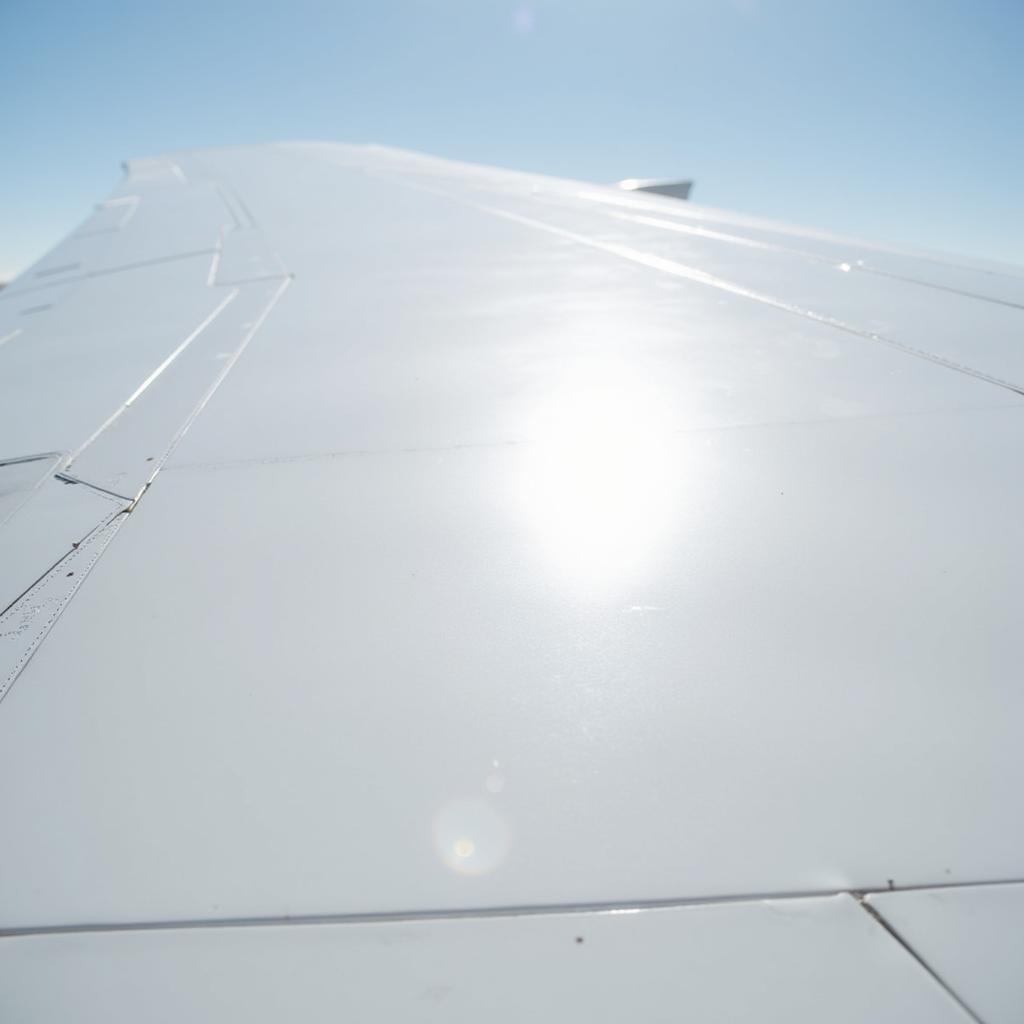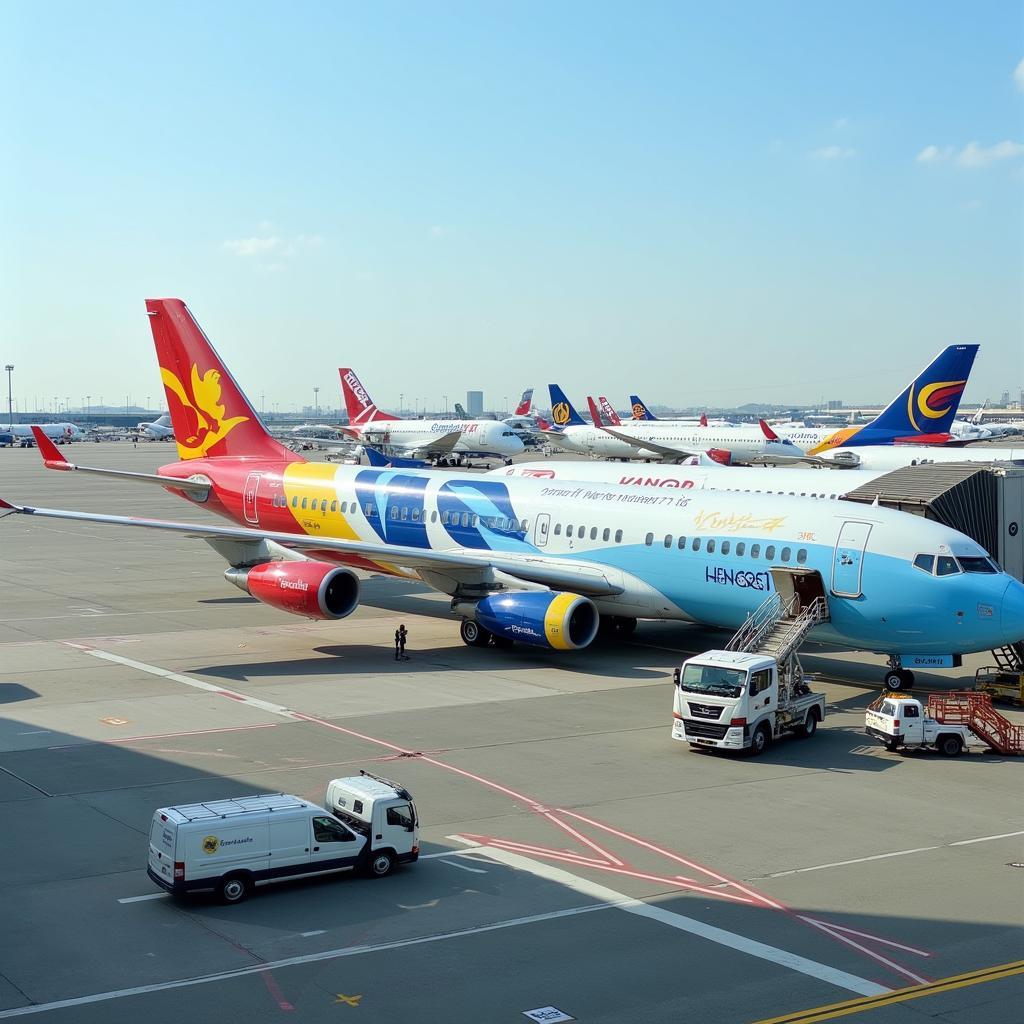Most people, when picturing an airplane, envision a white fuselage soaring through the blue. And they wouldn’t be wrong. White is, indeed, the most common color for aircraft. But why? De Qué Color Son Muchos Aviones? Let’s explore the fascinating reasons behind this prevalence and delve into the colorful exceptions that grace our skies.
The Dominance of White: Why So Many Airplanes Share This Hue
White reigns supreme in the aviation world for a multitude of practical reasons, making it the go-to choice for airlines globally. It’s not just about aesthetics; it’s about science and cost-effectiveness.
Thermal Regulation: Keeping Cool Under Pressure
One of the primary reasons for white’s popularity is its ability to reflect sunlight. This reflectivity helps keep the aircraft cooler, reducing the need for excessive air conditioning, thus saving fuel and money. Darker colors absorb more solar radiation, leading to a significant temperature increase inside the plane, particularly during prolonged ground operations in hot climates.
Visibility and Safety: Standing Out Against the Blue
White also enhances visibility against the backdrop of the sky and ground. This improved visibility aids in spotting potential damage, such as cracks or leaks, during pre-flight inspections. It also makes the aircraft more conspicuous to other aircraft and air traffic control, enhancing overall safety.
Preventing Fading and Damage: Protecting the Aircraft’s Exterior
The sun’s ultraviolet (UV) rays can cause paint to fade and deteriorate over time. White reflects these harmful rays, minimizing the impact of UV radiation on the aircraft’s exterior and extending the lifespan of the paint job, ultimately reducing maintenance costs.
 White Airplane Fuselage Reflecting Sunlight
White Airplane Fuselage Reflecting Sunlight
Beyond White: Exploring the Colorful Spectrum of Aircraft Liveries
While white dominates, airlines often incorporate other colors into their liveries, creating unique and recognizable brand identities. These splashes of color add personality and allow airlines to stand out in a crowded market.
Branding and Recognition: Making a Statement in the Sky
Airline liveries are carefully designed to reflect the company’s brand and values. Bright and vibrant colors can evoke feelings of excitement and adventure, while more subdued tones might project an image of sophistication and reliability. These colors become synonymous with the airline, creating instant recognition among travelers.
Cultural Significance: Reflecting National Identity and Pride
Some airlines incorporate national colors or symbols into their liveries, showcasing their country of origin and fostering a sense of national pride. These designs can range from subtle accents to elaborate patterns that celebrate cultural heritage.
Special Liveries: Commemorating Events and Partnerships
Airlines often introduce special liveries to commemorate specific events, partnerships, or causes. These limited-edition designs can feature unique color schemes and graphics that generate buzz and capture public attention.
 Colorful Airplane Liveries at an Airport Tarmac
Colorful Airplane Liveries at an Airport Tarmac
De Qué Color Son Muchos Aviones?: Frequently Asked Questions
-
Why are most airplanes painted white? White reflects sunlight, keeping the aircraft cooler and reducing the need for excessive air conditioning. It also enhances visibility and protects the exterior from UV damage.
-
Are there any disadvantages to painting an airplane white? While white offers numerous benefits, it can make it harder to spot dirt and grime, requiring more frequent cleaning.
-
What are some examples of airlines with unique liveries? Southwest Airlines, known for its bold blue, red, and yellow design, and Emirates, with its distinctive red and white tail fin, are prime examples.
-
How often do airlines repaint their planes? Typically, airlines repaint their aircraft every 5-10 years, depending on the condition of the paint and the airline’s branding strategy.
Conclusion: A Spectrum of Reasons Behind the Colors of the Sky
While white remains the dominant color for aircraft due to its practical advantages, the world of aviation is not devoid of color. Airlines leverage color to express their brand identities, celebrate cultural heritage, and commemorate special occasions. So, de qué color son muchos aviones? While predominantly white, the answer is ultimately a spectrum of hues, each telling a story about the airline and its connection to the world.
Need help with color selection for your next project? Contact us at Phone: 0373298888, Email: [email protected] or visit us at 86 Cầu Giấy, Hà Nội. We have a 24/7 customer service team ready to assist you.

